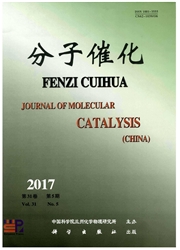

 中文摘要:
中文摘要:
以不同温度焙烧TiO(OH)2得到的TiO2为载体,采用湿法浸渍法制备RuO2/TiO2-C(C=450、550、650及750℃)催化剂,利用XRD、N2吸附-脱附、TEM和H2-TPR等表征手段研究催化剂的物理化学性质,并对其在HCl氧化反应中的催化性能进行考察.结果表明:载体焙烧温度对催化剂的结构与活性有显著影响.随着载体焙烧温度(≤650℃)的升高,RuO2与TiO2之间的晶面匹配度逐渐变高,促进了RuO2在TiO2表面的分散,其中RuO2/TiO2-650催化剂表现出最优的催化性能.而当载体焙烧温度过高时,RuO2/TiO2-750催化剂的反应活性大大下降,可能是由于过高的焙烧温度导致载体出现严重的烧结团聚现象,以及RuO2与TiO2之间过强的相互作用,阻碍了HCl氧化反应的进行.此外,减小RuO2的粒径可以促进HCl氧化活性的提升.动力学结果显示,催化剂表面的HCl氧化反应主要受O2分压的影响,表明O2从催化剂表面的解离吸附为决速步骤.
 英文摘要:
英文摘要:
RuO2/TiO2-C (C=450, 550, 650 and 750 ℃)catalysts were prepared using wet impregnation with metatitanic acidas as precursor, which were calcined at different temperature. Based on the characterizations from various techniques, including XRD, N2 adsorption-desorption analysis, HRTEM and H2-TPR, the physical and chemical properties of the catalysts were revealed. The performance of catalysts for gas-phase HCl catalytic oxidation to Cl2 were also investigated. The results showed that the calcination temperature of the support had effects on the structure of catalysts and the activity of HCl oxidation. RuO2 was loaded on the support calcinated at lower temperature (≤650 ℃), while the match-degree between RuO2 and TiO2 increased with the elevated support calcination temperature. This promoted the dispersion of RuO2 on the support, and the best catalytic performance over RuO2/TiO2-650 was observed. Further increase of the TiO2 calcination temperature led to a seriously decline of the activity of RuO2/TiO2-750. The inhibition of HCl oxidation was related to the agglomeration of the support and its too strong interaction with the active sites which was mainly caused by the high calcination temperature. In addition, we found that the decrease of average particle size of RuO2 could enhance the active of HCl oxidation. Kinetic studies showed that the partial pressure of oxygen was significantly effected HCl oxidation over catalyst which meant the dissocative dsorption of oxygen is the rate-determining step of the reaction.
 同期刊论文项目
同期刊论文项目
 同项目期刊论文
同项目期刊论文
 期刊信息
期刊信息
